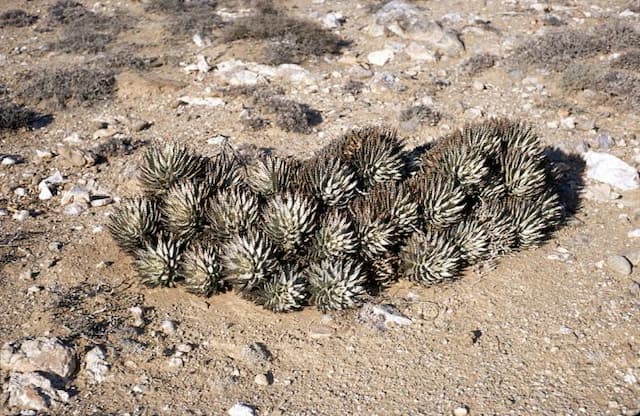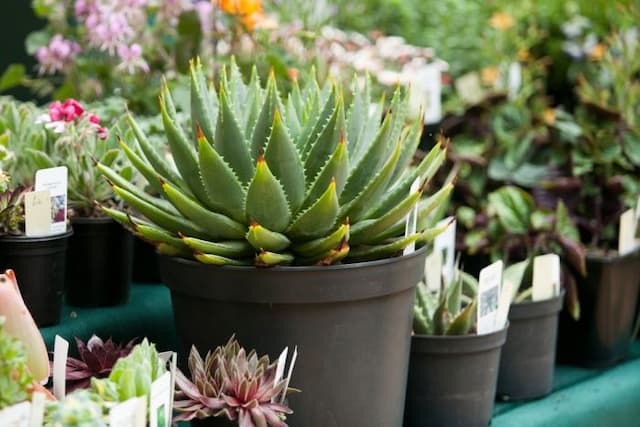Red Hot Poker Kniphofia 'Fiery Fred'

ABOUT
Kniphofia 'Fiery Fred', commonly known as Red Hot Poker, is a striking perennial that features bold and vibrant blooms. The most distinctive characteristic of this plant is its flower spikes, which consist of densely packed, tubular flowers. These blossoms are arranged in a striking, elongated cluster at the top of a sturdy, upright stem. The flowers exhibit a gradient of color, typically fiery shades that transition from red at the tip, to orange, and then yellow towards the base of the spike, reminiscent of a flickering flame. The foliage of the Red Hot Poker forms a clump at the base of the plant, with long, slender, arching leaves that are grass-like in appearance. The leaves are a rich green color and provide a nice contrast to the brightness of the blooming spikes. Blooms typically appear in the warmer months, creating a dramatic and eye-catching display in a garden setting. The overall visual appeal of 'Fiery Fred' lies in its bold coloration and the architectural quality of its flower spikes, which add vertical interest to any planting area. The warm tones of the flowers are particularly effective when backlit by the sun, which enhances their glowing hues. The plant's striking form and color palette make it a popular choice for gardeners looking to add a touch of drama to their landscapes.
About this plant
 Names
NamesFamily
Asphodelaceae
Synonyms
Torch Lily, Red Hot Poker, Tritoma
Common names
Kniphofia 'Fiery Fred'.
 Toxicity
ToxicityTo humans
Red hot poker, including the 'Fiery Fred' variety, is not known to be toxic to humans. However, as with many plants, individual sensitivities can vary, and ingesting plant material may cause gastrointestinal discomfort or allergic reactions in some people. It is always advised to prevent the ingestion of any plant parts if the toxicity is uncertain.
To pets
Red hot poker, including the 'Fiery Fred' variety, is not listed as toxic to pets such as dogs and cats. However, ingestion can still potentially lead to mild gastrointestinal upset due to the ingestion of non-food items. As with human ingestion, there can be individual sensitivities, and pet owners should discourage their pets from eating plants.
 Characteristics
CharacteristicsLife cycle
Perennials
Foliage type
Evergreen
Color of leaves
Green
Flower color
Mixed
Height
3 feet (91 cm)
Spread
2 feet (61 cm)
Plant type
Bulb
Hardiness zones
6
Native area
South Africa
Benefits
 General Benefits
General Benefits- Attracts Pollinators: Kniphofia 'Fiery Fred', commonly known as Red Hot Poker, produces vibrant flowers that attract bees, butterflies, and hummingbirds, supporting local ecosystems.
- Drought Tolerance: Red Hot Poker is known for its ability to withstand periods of low water, making it suitable for xeriscaping and drought-prone areas.
- Low Maintenance: This plant is relatively easy to care for, requiring minimal upkeep once established, making it ideal for gardeners of all levels.
- Long Blooming Season: Red Hot Poker has a long flowering period, providing color and interest in the garden throughout the summer and sometimes into fall.
- Architectural Interest: With its unique flower spikes and grass-like foliage, Red Hot Poker adds height and texture to garden beds and borders.
- Pest Resistance: Red Hot Poker is not commonly affected by pests, reducing the need for chemical interventions in the garden.
- Versatility in Landscaping: It can be used in various garden styles, including cottage gardens, coastal gardens, and contemporary landscapes.
- Improved Soil Health: The roots of Red Hot Poker can help in breaking up heavy soils and improving soil structure over time.
- Seasonal Interest: The leaves of Red Hot Poker can change color in the fall, providing additional seasonal interest in the garden.
- Seed Head Interest: After blooming, the seed heads can add a textural element to the winter garden when left uncut.
 Medical Properties
Medical PropertiesThis plant is not used for medical purposes.
 Air-purifying Qualities
Air-purifying QualitiesThis plant is not specifically known for air purifying qualities.
 Other Uses
Other Uses- Textile Dyeing: The fiery red-to-orange color of red hot poker flowers can be used to create natural dyes for textile dyeing, tapping into eco-friendly and traditional dyeing methods.
- Photography: The striking blooms of red hot poker serve as an excellent subject for macro photography, offering vibrant contrast and intricate details for photographers.
- Crafts and Arrangements: Dried red hot poker flowers can be used in flower arrangements, wreaths, or other craft projects for their unique shape and texture.
- Garden Art: The torch-like flower spikes can inspire garden art and sculptures, especially in Southwestern or contemporary garden styles where vertical elements are desired.
- Culinary Garnish: Though not widely known for edibility, the blooms can be used as a bold garnish for culinary presentation, provided they are free of pesticides and safe to consume.
- Educational Tool: Red hot poker plants can be used in educational gardens to illustrate plant adaptation, pollination, and the ecological significance of attracting hummingbirds and bees.
- Theme Gardens: They can be incorporated into fire-themed gardens or volcanic landscape designs because of their flame-like flowers.
- Nectar Source for Homemade Syrups: While not common, the nectar from the flowers could potentially be harvested to make small batches of homemade sweet syrups with unique floral undertones.
- Mood Enhancement: The vibrant and unique appearance of red hot poker can be used in horticultural therapy settings to improve mood and stimulate visual interest.
- Frost Protection: The dense foliage at the base of the plant can be utilized in the garden to provide microclimate ground cover, which may help protect smaller, frost-sensitive plants.
Interesting Facts
 Feng Shui
Feng ShuiThe Red Hot Poker is not used in Feng Shui practice.
 Zodiac Sign Compitability
Zodiac Sign CompitabilityThe Red Hot Poker is not used in astrology practice.
 Plant Symbolism
Plant Symbolism- Attention-grabbing: The bright, striking colors of the Red Hot Poker flower demand attention, symbolizing a need to stand out or be noticed.
- Strength and Boldness: Red Hot Pokers have a robust and sturdy appearance, representing strength, assertiveness, and courage.
- Vibrancy and Vitality: The vigorous growth and vibrant colors of the flower can symbolize an energetic life or the presence of high energy in a situation.
- Transformation: Red Hot Poker blooms undergo a transformation as they mature, often changing color, which can represent change or personal growth.
 Water
WaterRed Hot Poker, or Torch Lily, prefers consistent moisture, especially during hot and dry periods. Water the plant deeply once a week, providing approximately 1 inch of water to saturate the soil around the roots. In hotter climates or during particularly dry spells, increase watering to twice per week. Ensure the soil drains well to avoid waterlogging, as Red Hot Poker is susceptible to rot in soggy conditions. During winter, when the plant is dormant, reduce watering to prevent excess moisture around the roots.
 Light
LightRed Hot Poker thrives in full sun and should be planted in a location where it can receive at least 6 to 8 hours of direct sunlight daily. The intense light promotes vigorous growth and optimal flower production. If grown in too much shade, the plant may not bloom as prolifically and could become leggy as it stretches toward the light source.
 Temperature
TemperatureRed Hot Poker is hardy and can tolerate a range of temperatures but grows best when the climate is warm. It can survive minimum winter temperatures down to 20°F, but the ideal growing conditions are between 50°F and 85°F. When temperatures rise above 90°F, provide additional water to keep the plant hydrated and healthy.
 Pruning
PruningPrune Red Hot Poker in late winter or early spring before new growth begins. Remove old foliage to tidy up the plant and improve airflow, which can help prevent disease. It's also beneficial to deadhead spent blooms to encourage new flowers. Pruning is typically done annually, and it's the best time to divide overcrowded clumps to rejuvenate the plant and encourage vigorous growth.
 Cleaning
CleaningAs needed
 Soil
SoilRed hot poker, including 'Fiery Fred', thrives in well-draining soil with a pH ranging from 6.0 to 6.5. A good mixture would be loam-based with added compost and sharp sand to improve drainage and fertility. Kniphofia prefers soil that is rich but not overly fertile to avoid excessive foliage at the expense of flower spikes.
 Repotting
RepottingRed hot poker plants like 'Fiery Fred' are typically not repotted often as they are perennial plants that prefer to be undisturbed. Repotting can be done every 3-5 years or when the plant is visibly overcrowded.
 Humidity & Misting
Humidity & MistingRed hot poker plants such as 'Fiery Fred' are adaptable to a wide range of humidity levels and do not require high humidity to thrive. Normal outdoor humidity conditions are suitable for this plant.
 Suitable locations
Suitable locationsIndoor
Provide bright light and good airflow for red hot poker.
Outdoor
Plant in full sun, well-draining soil, divide every 3-5 years.
Hardiness zone
5-9 USDA
 Life cycle
Life cycleRed hot poker 'Fiery Fred' starts as a seed, germinating in warm, moist soil conditions to produce a small sprout. This sprout develops into a juvenile plant with a rosette of narrow, strap-like leaves, and as it matures, it increases in size through vegetative growth. Upon reaching maturity, the plant sends up tall flower spikes bearing tubular flowers that range in color from red to orange, which are pollinated by birds, bees, and other insects. After pollination, seeds form and are dispersed by wind or wildlife, allowing the cycle to begin anew. In the absence of seed generation, the plant may also spread through rhizomatous growth, with new shoots emerging from the root system. Seasonally, the plant experiences a period of dormancy, usually in the winter, where growth slows down until favorable conditions return in the spring.
 Propogation
PropogationPropogation time
Spring-Early Summer
The most popular method of propagation for Kniphofia 'Fiery Fred', commonly known as Red Hot Poker, is by division. The best time to propagate by division is in the spring, just as the new growth emerges. To divide Red Hot Poker, carefully excavate around the plant to lift the clump from the ground with as little root disturbance as possible. Using a sharp knife or spade, divide the clump into smaller sections, ensuring that each section has at least one growth point. Replant the divisions promptly at the same depth they were originally growing, spacing them about 18 inches (approximately 46 centimeters) apart to allow sufficient room for growth. Water the new divisions thoroughly to help establish them. This method is advantageous for maintaining the vigor of the parent plant and provides an exact clonal match, ensuring the preservation of its specific characteristics.









